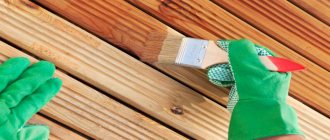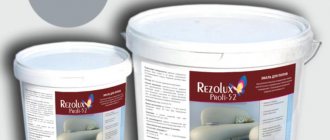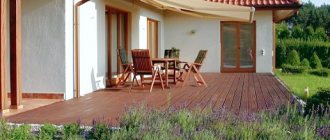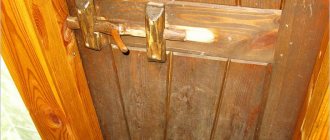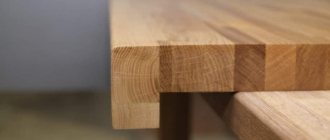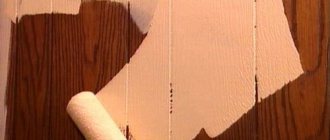A material such as wood has always been in demand, since it is a natural material and no newfangled plastics can compete with it in the ability to create an atmosphere of comfort and warmth in a room. But, like any other material, wooden products require protection and care.
For these purposes, special stains and varnishes are used. Treating wood with such means not only protects it from excessive exposure to light, moisture, scratches, and dirt, but also gives it nobility and sophistication.
Color spectrum
Beitz is a unique product that helps give wood a noble shade.
The structure of the wood is heterogeneous, different areas are impregnated unevenly, therefore, after the composition dries, an original pattern is created on the surface. The most popular shades of stains are included in the wood range; their names correspond to different types of wood. When purchasing, you should carefully consider the samples on which the stains are applied, because the shade on the label and in reality may not match. The finished color will depend on the following factors:
- original wood shade;
- degree of porosity of the material;
- density;
- breed;
- amount of resin.
Deciduous wood is impregnated much better than coniferous wood, so the tone will be as close as possible to the stated one. To give a light shade, you can purchase a lightening impregnation, which also tends to emphasize the wood grain. There are even colorless stains on sale that do not change the color of the wood, but still have full protective properties.
What are protective impregnations for wood?
Impregnations often include all compounds used for wood processing. This is not correct, since stains, primers and antiseptics are independent products. Impregnations are protective compounds that perform one specific task. According to this principle, they are classified into the following groups:
- waterproof - designed for structures in contact with water or located in rooms with high humidity. These compositions prevent the appearance of putrefactive lesions and changes in geometric parameters, protect the tree from freezing;
- biocidal – protect wood from microorganisms;
- fire retardant - increase the degree of fire resistance of wood, help slow down the spread of flame.
When choosing a composition, it is necessary to take into account the absorbency of wood, the conditions of its operation and the period for which it is necessary to protect the structure from a negative factor.
Impregnations are produced colorless or imitating the color of expensive wood species. The composition can be based on water or an organic solvent, which allows you to select products for interior and exterior work. The duration of treatment effectiveness depends on the concentration of active substances. This must be taken into account when choosing compositions for structures located in hard-to-reach places.
How to choose the right stain
Stain or, as it is also called, stain is a finishing coating for wood, which, without painting, favorably emphasizes its structure. It consists of a pigment and a base, which can be water, alcohol, or oil. Recently, water-based stains based on acrylic resins have become very popular. In addition to being decorative, they have the properties of a good antiseptic.
Another type of stain is wax. The thin film of wax that forms when covering the surface with stain gives not only the decorative effect of natural wood, but also reliably protects it from water.
When choosing a stain, you must be guided by the following criteria:
- Operating environment (external or internal work). Exterior stains contain pigments that are resistant to ultraviolet rays.
- Composition safety. In children's rooms or children's household items, stains without harmful compounds are used. These include water-, oil- or wax-based stains.
- Powdered or ready-made stain. Water and alcohol stains are also available in dry form. They must be bred at home. If there is any doubt that the desired result will be obtained, then it is better to give preference to ready-made stain.
- Method of applying stain to a surface. It is better to apply alcohol stains with a spray gun, as they dry very quickly and it is difficult to achieve an even coating. Small objects and surfaces are covered with brushes, foam rubber or fabric swabs. For a large finishing area, use a sprayer.
- Design solution for interior or exterior. It is important to know that the sample presented in the store often differs in color from what is obtained during finishing. The reason for this may be different species and structure of the tree, lighting. Even different batches of the same type of stain have differences in shades when coating.
What is wood antiseptic
Antiseptics are designed to fight fungus, insects and microbes. The fungus destroys the wood and turns it an unpleasant bluish-green, grey, white or black color. Mold that forms on the surface of wooden structures and products also does not add to their attractiveness.
The use of antiseptics is a preventative measure for protecting wood, which helps protect the wood from the appearance of signs of biological damage. Antiseptics, depending on the chemical composition, are divided into the following types:
- water-soluble - penetrate well into the wood structure, do not interfere with the penetration of air, intended for internal use;
- based on organic solvents - moisture-resistant compositions of deep penetration. Scope of application: processing of external structures and internal work;
- oil-based - form a protective film on the surface that prevents the penetration of moisture necessary for the life of microorganisms and insects. Used for structures exposed to groundwater, moisture, and precipitation. Usually have a pungent odor;
- combined - in addition to antiseptic properties, they have fire retardant properties, due to which they increase the fire resistance of wood or are able to paint the material in a certain color.
When choosing an antiseptic, it is necessary to take into account the location and operating characteristics of structures or products.
Using antiseptics for interior work
Organic and water-soluble antiseptics are used on internal surfaces; they dry quickly and do not contain substances harmful to human health. These compounds are durable and reliably protect against fungal or mold damage and insects. Scope of application: window frames, walls, flooring, joists, attic floors, stairs, etc.
Using antiseptics for external work
To protect external surfaces, it is better to use oil- and organic-based antiseptics. They form a protective film on the surface that is not destroyed under the influence of water, sunlight, blue light and biological damage. Hard-to-reach structures - joists, subfloors, interfloor and attic floor beams, the lower crowns of wooden houses - must be treated with strong antiseptic agents with protection effectiveness for more than 30 years. They penetrate deeply, are not washed out and have an increased concentration of active substances.
Preservative antiseptics
Separate attention should be paid to preservative antiseptics. They are used at construction stages, for example, during the procurement of material (brought and left until spring) or when work is temporarily suspended (shrinkage of the log house). Such compositions do not change the color and properties of the wood and effectively protect it for a long time.
Antiseptics can not only protect clean, uninfected lumber, but also combat the consequences of damage by microorganisms and insects. To treat affected surfaces, special formulations are used that differ in their effectiveness, which is what you need to pay attention to when choosing an antiseptic.
When choosing an antiseptic, do not forget about the absorption parameters of a particular wood. There are three types:
- difficult to absorb (spruce, fir, beech, birch, oak, elm, ash)
- medium absorbent (alder, maple, aspen, larch, linden)
- easily absorbed (sapwood of birch, pine, beech)
Popular manufacturers
Today there are a large number of stains from different manufacturers on the market. It is difficult to choose the best: many products are of excellent quality and have a reasonable price. You can buy stains at any hardware store: IKEA, Maxidom, Leroy Merlin and others. The selection of a good stain for woodwork can be done from the following list:
- "Novbytkhim" (NBH). Water-based, odorless stain that forms an abrasion-resistant coating. Helps to tint doors, baseboards, railings, trim, boards and other products. It has a rich palette of shades and can be used in decoupage.
- Coswick Wood Stain. Alcohol stain for tinting and protecting wooden bases. Helps to repair minor scratches, chips, and finish edges when installing parquet. Combines perfectly with varnishes.
- "Rainbow 21". Acrylic stain contains special substances to protect against mold and wood-destroying fungi. Has a high degree of adhesion to all types of wood.
- Zar. A quick-drying composition for interior and exterior work, with a self-leveling structure. Apply to wood without stains or streaks.
- Tikkurila Pirtti (Tikkurila Pirtti). A colorless stain that can be tinted according to the Tikkurila pigment catalog in absolutely any color: mocha, antique, villa and others (36 glaze shades).
- Liberon. It is used for the restoration and protection of wooden surfaces, suitable for indoor and outdoor work. The product is resistant to UV radiation.
- Varathane (“Varatan”). Oil stain made from transparent soybean oil, has pure natural shades, and is characterized by deep penetration into the wood.
- Zerwood. Stain is water-based and comes in many colors to match noble types of wood.
- Minwax (“Minwax”). Oil impregnation, which gives beautiful shades to wood and protects products from water and ultraviolet radiation.
- Pinotex Interior (“Pinotex Interior”). Water-based decorative impregnation is widely used for finishing work and protecting wood from external factors.
- "Krafor". The product is used on products used inside and outside buildings. The finished coating is highly polished and does not require varnish.
- "Biotex Universal". Antiseptic impregnation, highlights the wood structure, gives a beautiful shade, extends service life.
- "Vertex". A popular inexpensive water stain that comes in a wide range of shades: rosewood, ebony, beech, walnut and many others.
- Tury. A wood-protective stain that produces an attractive matte finish. Emphasizes the structure of wood, protects against microorganisms.
- Renner. Concentrated product with an emphasizing effect, water-soluble, has 17 basic shades.
- "Latek". Used to highlight wood fibers. Does not fade under the influence of light, is applied evenly, and has high moisture resistance.
- "Belinka". A wax-based wood coating designed for long-term protection of wood from any external factors.
- Herlac. A line of environmentally friendly stains without harmful components. Can be used for any joinery, chipboard, lining, veneer.
Impregnation for wooden surfaces
Wood is a material that ideally combines the qualities a person needs for comfort.
It is beautiful, durable, environmentally friendly and affordable for most consumers. Buildings made of wood are able to preserve for a long time the natural warm color, the unforgettable smell of wood and give the owners a feeling of coziness and comfort. Impregnation of wood can be deep or superficial. Surface protection is created by bio- and fire-retardant impregnation, which saturates the wood with special substances. It is more often used for interior work, where the main goal is to preserve the natural texture of wood and its aesthetic appearance. Deep impregnation is considered more effective and ensures maximum penetration and uniform distribution of the protective composition into the wood. Deep impregnation can only be carried out in industrial conditions, where protective solutions are introduced under pressure into the capillaries of wood. According to their actions, wood impregnation is divided into two types:
- Fire retardants - protect wood from fire and decay, without reducing the natural beauty of the material. Fireproof protection with fire retardants is used for wooden structures in residential, industrial and public buildings.
- Biocides - reliably protect wood from the destructive effects of fungus, insects, mold and significantly increase the service life of a wooden structure.
Sequence of work
High-quality finishing is obtained only on a surface that is free of dust, dirt and grease, without defects in wood processing. If the surface of the wood has already been painted with something, then the old finish must be completely removed. Coniferous wood needs to be deresined.
The cleaned surface is sanded twice. This is done first with coarser sandpaper (No. 120), then with finer sandpaper (No. 220). Wood sanding is carried out only along the grain. The resulting dust is removed with a damp cloth, and dirt with some solvent or alcohol.
The stain can only be applied to a clean and dry wood surface. In order not to make a mistake with the color of the coating, do a test paint job. You need to take a small sample. First, cover it with one layer of stain, after 2/3 of the sample has completely dried, cover it with a second layer. The third layer should cover 1/3 of the wood piece. This will allow you to choose the finishing option you like.
Application methods
With a brush you can apply almost any stain to the prepared surface. Difficulties arise only with alcohol-based stain due to rapid drying. The vertical surface begins to be covered from below so that smudges are not absorbed by unpainted wood. This significantly improves the uniformity of the coating.
The second and subsequent layers can be applied after the previous one has dried. For oil-based stains, the drying process lasts up to 3 days, for water-based stains - up to 3 hours. The coating is applied along the wood grain. When painting a surface with a brush, it is important not to go into adjacent areas that have already been treated with stain. This way you can avoid unwanted stains.
Water-based stain can lift wood grain. After the first layer, wait for the stain to dry and sand the surface with sandpaper. Then remove the resulting dust and cover the surface with the next layer.
The stain is applied using a swab by rubbing in. This method is only suitable for small surfaces. A tampon can be made from a piece of foam rubber or thick fabric. Wax sealants are applied using this method. It allows you to achieve uniform surface coverage. This is especially true for rocks with a porous structure.
Spraying stain onto a wooden surface is most often used for large areas of coverage. Alcohol-based stains dry quickly and during their application, for example, with a brush or swab, it is difficult to avoid spotting. Spraying with a spray gun allows you to achieve a high decorative quality of finish, regardless of the base of the stain.
Special stabilizing impregnations
Such compositions are used for processing marble and granite, joists, footrails and hidden surfaces, surfaces painted with lime or covered with plaster. Their main function is to strengthen the surface, enhancing adhesive, weather-resistant and water-resistant properties.
To extend the life of wooden structures, special impregnations are used that are designed to protect wood from rotting, pests, and also protect against fire.
Some types of impregnations can be used on carpets and fabrics to give them antiseptic and fire-retardant properties.
Work technology
The method of applying it depends on the type of stain. Typically, a brush, spray, swab, or sponge are used for painting work. It is better to treat unsmooth and large-sized bases with a spray gun (in the first case, do not use a brush so that there are no fallen bristles left on the wood). To use a sprayer, choose a lighter shade of stain: the layer will be thicker, making it appear darker.
Before the main stage of work, a test painting is always carried out to clarify the required number of layers to obtain the desired shade. The procedure is as follows:
- take a board of the same type as the base material and polish it;
- cover the product with impregnation;
- leave until dry;
- apply another layer to 2/3 of the board;
- after drying, treat another 1/3 of the workpiece with a third layer;
- As it dries completely, evaluate the appearance of all three areas and select the optimal shade.
Impregnations
The appearance of impregnations was caused by the need to give building materials additional characteristics: to make their surface more durable, heat-resistant and impervious to moisture, which, penetrating into any porous material, gradually destroys it from the inside. Impregnation is also indispensable when painting an old surface. It will allow you to compact the lower layers of paint, level the surface, give it a beautiful uniform color and significantly reduce paint consumption.
Modern construction impregnations have the following properties:
1. disinfectants
2. preservative
3. strengthening
4. water-repellent
5. antiseptic
6. anti-salt.
Dealing with defects
When applying stain, it is very important to avoid smudges, which are quickly absorbed into the wood and significantly worsen the appearance of the finish. A small amount of stain on the brush and a thin layer of coating can avoid this defect.
You can remove unwanted stains from stain using sandpaper, or in more difficult cases, with a plane. You will have to act carefully, gradually removing the darkened area of the wood and smoothing out sharp transitions.
For porous wood species in which the coating is absorbed unevenly, it is better to use wax-based stains or gel stains. They cover the surface with a thin layer and do not penetrate deep into the wood structure. You can also treat the surface of the wood with a special conditioner compound, which will prevent the active absorption of the stain.
The “apple-colored” defect occurs when pigment thinners are of poor quality or there is a lack of skill in spraying stain. Stains form on the surface covered with stain.
When applying stain with a spray gun, in order to avoid coating defects, it is necessary to adjust the material supply torch. It should be oval in shape and the spray angle should be approximately 90°.
Coating defects can arise from poor-quality sanding of the wood surface. In this case, it is necessary to remove the layer and sand it again. Then cover the surface with stain.
Remaining stains of grease and dirt due to poor cleaning will appear when applying stain. Here, too, it is necessary to remove the poor-quality layer by grinding, clean and degrease the surface. Apply a new coat of coating to clean, dry wood.
It happens that the stain is applied to the surface incorrectly. Here are the main ways to eliminate defects:
- For numbness. Immediately after tinting the wood, you need to cover the area with varnish, which will dissolve the stain. Then clean the treated area with a rag. When the drip has already dried, it will have to be softened with white spirit or ground off with sandpaper.
- For stains. If we are talking about plywood, you will have to remove all the veneer using a plane. Solid wood is also processed with this tool, removing the thin top layer.
Antiseptics
Antiseptics, like impregnations, are used to protect building materials from damage and destruction. They contain biocides and poisons that help destroy certain microorganisms and prevent their reappearance. The scope of application of construction antiseptics is extensive. They are used for treating lime and lime-cement surfaces, brick, concrete, joints between tiles, facades, plasters, walls, ceilings, and wooden structures. High-quality antiseptics have the following properties:
- they are safe for human and animal health, but are highly toxic to fungi, mold and insects;
- do not change the physical and mechanical properties of materials with which they come into contact;
- have the ability to penetrate deeply into concrete and wood;
- do not change their properties during storage and use.
Making your own stain
There are a large number of folk recipes for making stain at home. Various shades of brown can be obtained by preparing a solution of ordinary potassium permanganate. It is necessary to experiment a little to achieve the desired result, selecting the concentration of the solution. The surface stained with potassium permanganate must be protected from fading, for example, with varnish.
Another simple way to stain wood is to brew strong tea. It will give the wood a rich brown tint. You can also kill a tree with strong brewed coffee. The natural brown color comes from wood treated with a rich decoction of walnut shells, crushed to a powder.
A decoction of oak bark will give the wood a black tint. The golden color is obtained by treating wood with a decoction of buckthorn fruits. A red-brown tint can be obtained by treating a wooden surface with a concentrated decoction of onion peels.
Types of construction antiseptics
Building materials such as brick, concrete, plaster, and dry mixes are also susceptible to fungal infections. As a result, the material cracks and swells, which leads to the appearance of unsightly dark spots on the walls, peeling of the plaster and chipping of fragments of brick and concrete. In some cases, experts advise introducing a sanitizing antiseptic into the building material at the stage of its manufacture.
According to the scope of application, all antiseptics are divided into several types:
- Antiseptic for wood.
Natural wood is widely used in construction, but if used incorrectly, it very quickly deteriorates and collapses, and this in turn leads to huge losses. It is possible to achieve long-term preservation of the strength of wood. This is why there are modern construction antiseptics, which are used everywhere today.
According to the type of application, all antiseptics are divided into oil-based and water-soluble. Both types have the same main effect - they protect the tree from destructive microbes and bacteria.
The appearance of fungus and mold on the walls of damp, poorly ventilated rooms is not uncommon. Basements, cellars, storage rooms, and rooms with poor ventilation are most susceptible to infection. Modern non-toxic and hypoallergenic antiseptic compositions are effective not only on concrete, but also on brick bases. They disinfect the surface and prevent the appearance of new mold and germs. Manufacturers provide a guarantee of up to ten years for the protective effect of some types of antiseptics. But we should not forget that much depends on the operating conditions in which the object is located.
- Antiseptic for plaster.
Allows you to significantly improve the appearance of the surface and increase its service life. This antiseptic can be used as a protective base for any subsequent coating.
It is recommended to use before starting exterior finishing work. This treatment of facades eliminates microbiological contamination and prevents subsequent destruction of the surface. External antiseptics are effective in combating
with mold (antifungal effect), lichen, moss, blue-green algae and bacteria. Plaster, paint and other finishing materials adhere much better to a surface treated with this composition. Facade antiseptic allows you to increase the service life and improve the quality characteristics of the external surfaces of buildings.
Cons of varnish
- priming (protection from microbes and adverse effects of weather conditions);
- grinding;
- long drying.
Equally important! Basically, varnishes are toxic and negatively affect a person’s well-being (cause headaches).
- the need to apply at least two layers;
- the smell of varnish can last a long time;
- little cover.
Varnishes based on water are the safest.
Multi-colored dyeing
Wood stain, what is it for? It would seem that the technology and material have long been known. But the question remains open for many. Staining wooden surfaces is done in order to give them a certain shade that emphasizes the texture of the wood. In addition, stain makes the wood stronger and more resistant to damage from dampness, mold, fungi and wood-boring insects. But the possibilities of staining do not end there. Using stains of different colors you can create various effects on a wooden surface:
- whitening;
- aging;
- colored stains.
To create a bleached surface, two compositions of different qualities are used. First, a continuous coating is made with white water stain, which is thoroughly dried. And then all the recesses and pores are filled with an oil-based stain with the addition of hard wax. In this case, a very thin waxy film is formed, which highlights only the pores in black or gray, while the rest of the surface remains whitish.
If it is necessary to obtain a multi-colored effect, then first a test is made to select shades on a separate piece of sanded board. When it is possible to achieve the desired color combination, we begin processing the product. First, the main background is applied. Then chaotic or ordered strokes are made over it with other color shades of stain. The finale will be a final coating with clear or tinted varnish.

